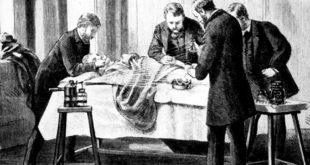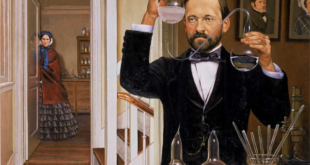This article was originally published in the Pharmaceutical Journal and Transactions, April 7, 1877, pp. 827-828
REVIEW

On Fermentation. By P. Schützenberger (Director at the Chemical Laboratory at the Sorbonne). H.S. King and Co. London: 1876
This work forms the 20th volume of the International Scientific Series, and as might be expected from the pen of the author, it constitutes an excellent digest of all that is known regarding the complicated phenomena of fermentation. Besides being complete in comprehensiveness, it is most readable and is enriched by the incorporation of the well known researches of Schützenberger.
The work before us is divided into two books, the first comprising thirteen chapters and the second, three chapters; there are further given a number of figures chiefly in illustration of the various kinds of ferments, and to show the processes of budding and spore formation.
Regarding fermentation as a particular instance of a biological reaction, manifesting itself as the result of the special force residing in organisms, Schützenberger adopts as nearly as possible the well known theory of Pasteur, and gives to that of Liebig little attention beyond enunciating its main features.
After briefly describing some historical observations in regard to fermentation, the author proceeds to consider more especially alcoholic or spirituous fermentation, and concludes that this is brought about through “a special mechanical action, exercised on the ultimate particles of the compound matter” (sugar), the result of which is that the sugar is split up into alcohol and carbonic dioxide, while glycerine and succinic acid are formed also at the expense of the sugar; besides this the sugar gives up matter to form new ferment. The lactic acid which generally accompanies alcoholic fermentation is considered as proved to be due to the presence of a minute amount of a foreign ferment.
Now Pasteur regards fermentation essentially “a correlative phenomenon of a vital act, beginning and ending with it,” so that wherever there is fermentation, there is organization, development, and multiplication of globules of the ferment itself. Liebig on the other hand neglected the element of life and regarded fermentation as due to a disturbance of equilibrium imparted to the elements of bodies by virtue of an existing change or motion in other bodies. Pasteur and Liebig have at no time in the history of the discussion between them relative to this matter agreed, and the last paper written by the illustrious Liebig was a refutation of some of the later inferences drawn by Pasteur on this subject.
Schützenberger says Liebig’s theory was borrowed from Willis and Stahl; possibly, but no one can dispute the right to it, the German chemist acquired by constructing through his own work the basis upon which he accepted and defended it. And after all there is remarkably little real difference between the theories of Pasteur and Liebig. Take that form of fermentation which is supposed by Bernard to cause the transformation of the glycogen of the liver into glucose; this effect of hydration is considered by Pasteur and his allies to be due to the influence of a special ferment in the blood, which, while it causes this change, reproduces itself from a apart of the matter it influences. Well, Liebig would rather have viewed the change apart from a vital process; it was enough for him to perceive the conditions existing necessary for the starch to take up water and become sugar–he did not see the necessity for believing the result due to a forma of lie; all that was required was the presence, the conte, of a body itself in process of change. One of his favorite illustrations of the theory bearing his name, was the reaction which occurs between peroxide of hydrogen and argentic oxide, which, when mixed, produce metallic silver and give off free oxygen,
H1O2 + Ag2O = H2O + Ag2 + O2
The peroxide of hydrogen being unstable, is constantly undergoing a change from the moment of its formation, which is attended with the liberation of oxygen, and immediately it is brought in contact with oxide of silver it gives to that body the same tendency; more, it causes its reduction to metal.
Brodie has explained this result on the hypothesis that the second oxygen in the peroxide of hydrogen is in a different polar condition to that of the oxygen in the silver compound, and that the two thus have an attraction for each other. However this may be, it deals rather with first causes of attraction, while the fact itself remains.
To conclude this digression, we may say that the only difference of note between the theories of Pasteur and Liebig is this; that while Pasteur cannot conceive an act of fermentation apart from life as a cause, Liebig would not admit this as a necessity while he recognized a cause; in both instances it will be seen that the direct cause is something in change.
Schützenberger then goes on to describe the life processes of yeast cells and their multiplication by budding and throwing off spores, after which he treats of their actual composition.
With regard to the inorganic side of this question, nothing can be more easily determine; it is known for instance that the ash of yeast consists essentially of phosphoric acid and potassium, together with a little magnesium and a trace of lime. And from this knowledge it is easy to make a medium in which yeast will flourish and reproduce itself, so far. But it is in regard to the nitrogenous substances in yeast that we know so little; even here, we can construct a solution containing nitrogen in various forms which is capable of being assimilated as food. Of the actual nature of the albuminous part of the yeast, we know extremely little beyond that it is albuminous.
We cannot pause to consider with Schützenberger the various condition upon which the life, health, and disease of yeast and other cells depend, but one experiment that he describes is so beautiful that we state it. It must be understood that Pasteur has established the fact that yeast respires like the higher animals, and that when free oxygen is not available, it can derive it from sugar. This attraction, or rather necessity for oxygen, Schützenberger illustrates by causing red arterial blood to circulate through a sufficiently long system of hollow tubes constructed of gold beaters’ skin, and immersed in a mixture of yeast diffused in fresh serum, without globules, at a temperature of 35°C. (95°F). Under these conditions the blood gives up its oxygen to the yeast through the walls of the tubes, and then passes out black and venous at the other extremity.
Incidentally, Schützenberger introduces some researches of his, relative to the determination of dissolved oxygen, which tend to show that in contact with sodic hyposulphite, it is divided into two parts, one of which goes to oxidize the hyposulphite, and the other to form peroxide of hydrogen. This, however, is a subject to which we hope to return on a future occasion. After describing and discussing the various other forms of fermentation, e.g., viscous or mannitic, lactic, ammoniacal, butyric, etc., he considers fermentation by oxidation, and finally comments upon the application of Pasteur’s researches. In the second book he treats of the nature of albuminous substances, or proteids with the view to understand the origin of ferments, and shows how impossible it is to do so, while our knowledge of the chemical constitution of albuminous substance is so meager. He recapitulates the sum of our information on these headings and further gives the results of his own investigations made by decomposing various forms of albumin with baryta water, a method which as nearly as may be, when in conjunction with a mild form of oxidation, imitates the wear and tear processes of life, those processes which give rise in the body to decomposition products of the living principles. This employment of baryta water is not new; others have used it before and since, but Schützenberger has certainly extended the results obtained by this method of inquiry. Thus, after confirming what was previously known, he details evidence to show that the albuminoids are constructed upon an association of urea and amino-acid combinations of various series. Schützenberger rests his discovery of the presence of the urea group in the albuminoids uon the fact that he has obtain ammonia and carbonic acid from them in the proportions necessitated by this assumption. He has also recognized among the decomposition products of albuminoids, guanine, sarcine, and xanthine. In this latter respect, however, he is not alone; simultaneously Thudichum arrived at similar results and has even gone further in certain directions.
Schützenberger gives also a chapter on soluble ferments and indirect fermentation and concludes his book with a review of the various views and researches relative to the origin of ferments.
 Pasteur Brewing Louis Pasteur – Science, Health, and Brewing
Pasteur Brewing Louis Pasteur – Science, Health, and Brewing 


